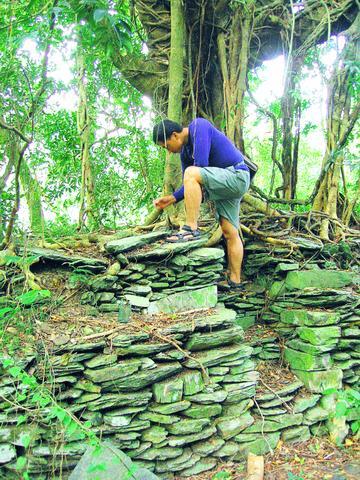Last Saturday, a group of 16 trekkers set off from the small town of Nanhe in Pingtung County on a journey that will take some of them the full length of the Central Mountain Range, the spine of Taiwan.
The trek, led by Wu Yuan-he (
The trek, which is taking place in what even the main organizing body, the Taiwan Forestry Bureau (

PHOTO: IAN BARTHOLOMEW, TAIPEI15TIMES
The purpose of the trek is to promote the Forestry Bureau's project to develop a National Trail Network across Taiwan in imitation of the Appalachian Trail in the US. The first four days of the trek, in which this reporter joined (further reports on this trek will be based on information provided by other participants), was a good indication of the enormous potential, and equally enormous problems the Bureau faces in establishing such a trail network.
The group set off July 19 after a small ceremony held in the playground of the Nanhe Primary School, which lurks under the very tail of the Central Mountain Range as it winds its way down to Kenting.
The first day's target was the settlement of Old Qijia, one of the most complete villages of Paiwan-style stone houses currently still inhabited. Although for part of the way, Wu led his trekkers through mountain trails, the town is actually accessible by four-wheel-drive, and sections of the road, especially in the lower reaches, which are inhabited by fruit farmers, are paved with cement.
From the White Stork Bridge along the Lili River, where we stopped for lunch, the trek moved rapidly out of the more intensively farmed lowlands and into the foothills, which were once the domain of the Paiwan Aborigines, but which have since largely been returned to wilderness.
Old Qijia, where we stopped for the night, receiving the hospitality of Guo Tung-xiong (
From Old Qijia, the trek moved off deeper into the mountains, and the trail deteriorated significantly, often disappearing into dense foliage. This is a continuation of the Kunlun-Au trail that joined Qijia and the even bigger Paiwan settlement for which we were heading, to the plains.
Our target was Gulou, which in its heyday was one of the largest Paiwan settlements in the area, with a population of over 1,000. The Japanese thought enough of it to establish a police and medical station there. All that remains, however, are ruins hidden among jungles of cactus, hemp and other plants, many of which one would expect to see in a tropical garden rather than a tropical wilderness. The abundance of brightly colored flora is one of the many indications of the highly sophisticated life that once existed in this now desolate spot.
The exploration of Guluo was the high point of this first short section of the trek. It had taken half a day more than expected to reach, after a wrong turn and a bad landslide created the need for a difficult and dangerous climb up a scree slope that rose 200m from the riverbed. Cutting through the superabundant vegetation exhausted even the most energetic of the trekkers and the difficulty in finding the correct road among a maze of likely-seeming alternatives -- some hunting trails, others red herrings -- frustrated some of the less experienced.

May 18 to May 24 Pastor Yang Hsu’s (楊煦) congregation was shocked upon seeing the land he chose to build his orphanage. It was surrounded by mountains on three sides, and the only way to access it was to cross a river by foot. The soil was poor due to runoff, and large rocks strewn across the plot prevented much from growing. In addition, there was no running water or electricity. But it was all Yang could afford. He and his Indigenous Atayal wife Lin Feng-ying (林鳳英) had already been caring for 24 orphans in their home, and they were in

President William Lai (賴清德) yesterday delivered an address marking the first anniversary of his presidency. In the speech, Lai affirmed Taiwan’s global role in technology, trade and security. He announced economic and national security initiatives, and emphasized democratic values and cross-party cooperation. The following is the full text of his speech: Yesterday, outside of Beida Elementary School in New Taipei City’s Sanxia District (三峽), there was a major traffic accident that, sadly, claimed several lives and resulted in multiple injuries. The Executive Yuan immediately formed a task force, and last night I personally visited the victims in hospital. Central government agencies and the

Australia’s ABC last week published a piece on the recall campaign. The article emphasized the divisions in Taiwanese society and blamed the recall for worsening them. It quotes a supporter of the Taiwan People’s Party (TPP) as saying “I’m 43 years old, born and raised here, and I’ve never seen the country this divided in my entire life.” Apparently, as an adult, she slept through the post-election violence in 2000 and 2004 by the Chinese Nationalist Party (KMT), the veiled coup threats by the military when Chen Shui-bian (陳水扁) became president, the 2006 Red Shirt protests against him ginned up by

As with most of northern Thailand’s Chinese Nationalist Party (KMT) settlements, the village of Arunothai was only given a Thai name once the Thai government began in the 1970s to assert control over the border region and initiate a decades-long process of political integration. The village’s original name, bestowed by its Yunnanese founders when they first settled the valley in the late 1960s, was a Chinese name, Dagudi (大谷地), which literally translates as “a place for threshing rice.” At that time, these village founders did not know how permanent their settlement would be. Most of Arunothai’s first generation were soldiers